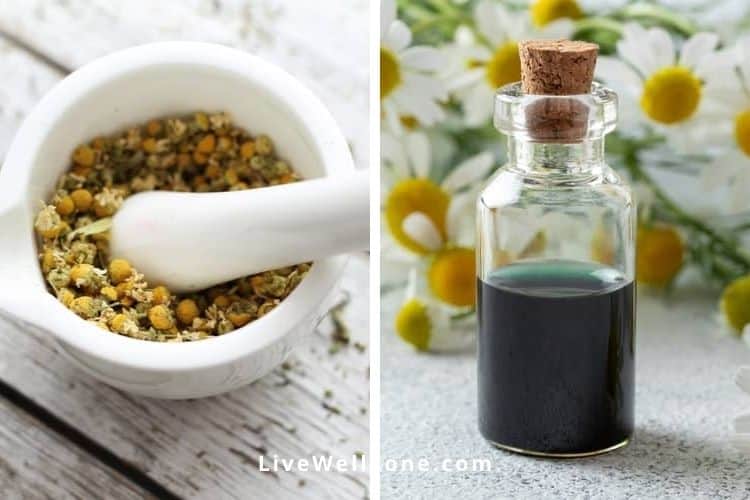
One of chamomile’s oldest – and sometimes, forgotten – uses is as a natural remedy for menstrual pain. Yep, these beautiful yellow flowers have really amazing anti-inflammatory properties that every woman should know about. So, if you’re curious to learn more about the use of chamomile for period pain, then keep reading because we’re going to explore:
- what modern research has to say about chamomile’s benefits for PMS.
- how to use chamomile tea for that time of the month (with two different recipes).
- tips for using chamomile essential oil for painful menstrual cycles (and which type of chamomile oil to use).
- how to use chamomile tincture (if you want a really easy method that doesn’t require any prep work).
Note: this post contains affiliate links and I earn a commission (at no additional cost to you) if you use them to make a purchase.
4 REASONS WHY CHAMOMILE IS GOOD FOR MENSTRUAL PAIN
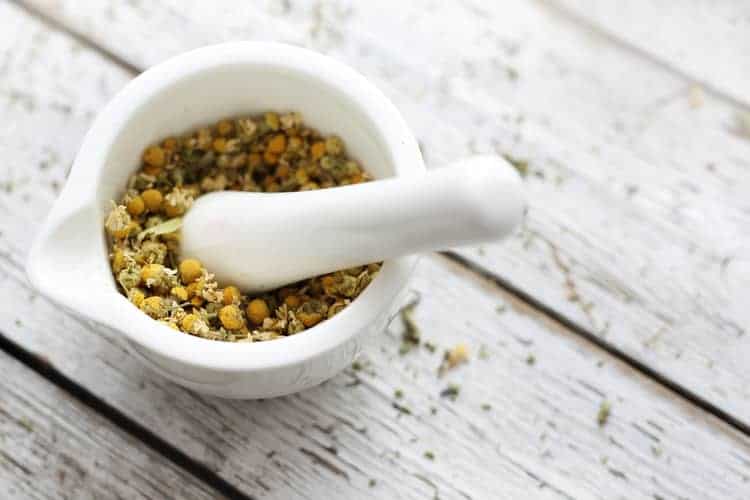
Research shows that chamomile has anti-inflammatory, antispasmodic and stress-releasing properties that are beneficial for menstrual pain as well as other PMS symptoms (such as anxiety and mood swings).
Here’s a closer look at how chamomile is actually able to do all this (the main reference for this information comes from this paper).
1. Anti-inflammatory, Analgesic (pain-relieving) and Antispasmodic
- Chamomile contains compounds like spiroethers, which reduce muscle spasms (such as the ones that occur in the uterus) and as such, results in less pain.
- Other compounds in chamomile that help with pain include volatile compounds like alpha-bisabolol and chamazulene, as well as antioxidants such as apigenin (source).
- Some research suggests that chamomile acts similarly to non-steroidal anti-inflammatory drugs (such as ibuprofen) by inhibiting the COX-2 enzyme. COX-2 produces hormones known as prostaglandins, which can have a pro-inflammatory effect and may contribute to painful menstrual cycles.
- In a study comparing chamomile extract and mefenamic acid (a non-steroidal anti-inflammatory drug) for menstrual pain, chamomile was found to be just as effective.
2. Antidepressant and Anti-anxiety
- Chamomile contains flavonoids (a group of antioxidants) that are said to be able to modulate neurotransmitters like serotonin, dopamine and GABA.
- Scientists believe that the ability to modulate specific neurotransmitters is what allows chamomile to ease anxiety (source). In fact, one particular flavonoid called apigenin, has been shown to bind to benzodiazepine receptors in the brain, producing a mild tranquilizing effect.
- Some studies confirm that chamomile’s calming effect is actually beneficial for PMS-related anxiety (source).
3. Supports The Liver and Hormones
- Chamomile has bitter compounds and traditionally, herbalists use bitter herbs to support the liver.
- Bitter compounds such as the ones in chamomile are said to stimulate the production of bile in the liver.
- Bile is an important part of detoxification because it transports toxins so that they can be excreted out of the body. Supporting this pathway goes a long toward long-term hormone balance.
4. May Support The HPA Axis
One more way in which chamomile is beneficial for the menstrual cycle is that it seems to modulate the HPA (hypothalamic-pituitary-adrenal) axis.
The HPA plays a key role in the menstrual cycle because the more active this axis is, the more cortisol the body releases.
Unfortunately, an increase in cortisol – especially when it’s chronic – can contribute to painful cycles as well as other menstrual imbalances.
So, it’s a good idea to do everything you can to support proper functioning of the HPA axis.
HOW TO MAKE CHAMOMILE TEA FOR MENSTRUAL CRAMPS
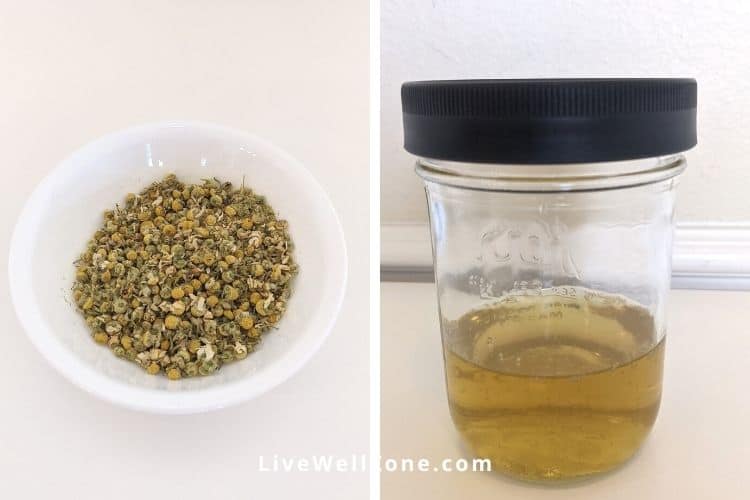
Making a truly effective chamomile tea for pain usually requires more herb than what is in a standard tea bag.
So, you can either use more than one tea bag for your tea or buy chamomile in bulk (visit my Resources page to see the companies I personally buy herbs from).
1. Basic Chamomile Tea Recipe
- 2 – 3 teaspoons dried chamomile flowers (1 – 2 tea bags, depending on the brand)
- 1 cup of boiling water
Instructions
1. Pour boiled water over the chamomile..
2. Cover fully and allow to steep for 10 – 15 minutes.
3. Strain out the flowers (or remove the tea bags).
4. Sweeten with raw honey if you wish and enjoy.
NOTE: make sure to use a teapot that fully covers the tea and doesn’t allow any steam to escape. Many of the beneficial compounds in the herb are volatile (aka essential oils) and can escape via steam while it’s steeping.
2. Long Infusion Chamomile Tea
Ingredients
- 2 tablespoons of dried chamomile flowers (about 2 – 4 bags, depending on the brand)
- 2 cups boiling water
Instructions
1. Place the chamomile in freshly boiled water.
2. Cover and steep for approximately 2 – 3 hours.
3. Strain out the flowers or remove the tea bags.
4. Sip on this tea throughout the day.
NOTE: this is a very bitter tea. You can add a little honey, but it won’t do much to change the bitterness. However, the benefits you get far outweigh the strong flavor.
3. Chamomile, Thyme and Honey Tea
Although thyme isn’t commonly associated with easing period pain, a small study showed that it reduced the risk of menstrual cramps by 63.2% (source).
This result isn’t very surprising given that thyme is known for being antispasmodic and anti-inflammatory (source).
Not only does thyme blend well with chamomile, but it helps reduce the bitterness that chamomile imparts to tea.
Ingredients
- 2 tsp dried chamomile flowers (or about 2 tea bags)
- 1 tsp dried thyme (or 1 tea bag)
- 1 cup boiling water
Instructions
1. Place the herbs in freshly boiled water.
2. Cover and steep for 10 – 15 minutes.
3. Strain out the herbs (or remove the tea bags).
4. Sweeten with a little honey and enjoy.
HOW TO USE CHAMOMILE OIL FOR PERIOD CRAMPS
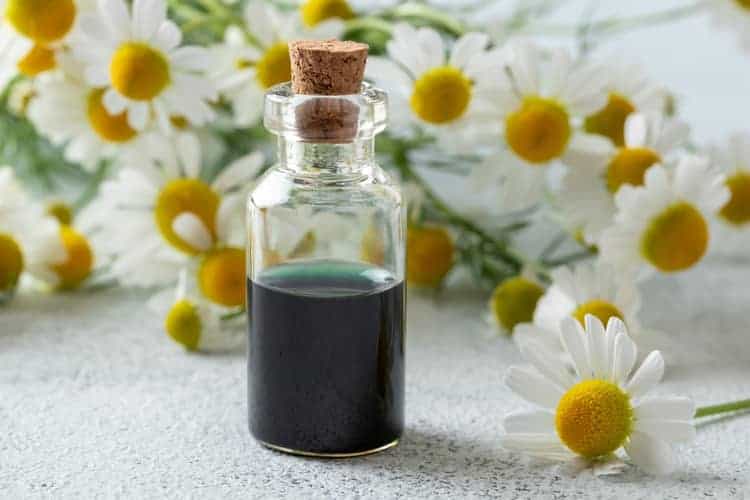
There are various types of chamomile essential oils on the market, including Moroccan, German (aka Blue) and Roman chamomile.
They all have anti-inflammatory and pain-relieving properties, but for period pain you want to go with German (Blue) chamomile oil (latin name: Matricaria recutita).
In fact, one of the medical papers I referenced earlier in this article indicated that the stronger the blue color, the better. This is because that deep blue shows that there’s a higher concentration of the compounds that ease PMS pain.
Now, when it comes to using blue chamomile oil, here are the steps to follow:
- Choose a lightweight, liquid carrier oil in which you will dilute the chamomile oil. This can be something like almond, jojoba or grapeseed oil.
- In general, it’s best not to exceed a 3% dilution for blue chamomile. This means no more than 27 drops of chamomile oil for every ounce of carrier oil.
- Mix the carrier oil and essential oil in a glass amber bottle.
- To use your blend, massage a small amount onto your lower belly and/or lower back. Experiment to see which area gives you the most relief.
- Re-apply as needed throughout the day for relief.
NOTE: you can also blend chamomile oil with other essential oils for menstrual cramps like peppermint, clary sage, copaiba or frankincense.
USING CHAMOMILE EXTRACT OR TINCTURE FOR PERIOD PAIN
A tincture is the most convenient way of using chamomile because there’s nothing to prepare.
You simply ingest the tincture according to the manufacturer’s instructions.
Now, if you’re not familiar with tinctures, they’re an extract of herbs in alcohol (in the same way that tea is also an extract, except you’re using water instead of alcohol).
If you’d like to try this method, then here’s a chamomile tincture to try.
CONCLUSION
Chamomile is so much more than just a sleep herb. It’s a potent anti-inflammatory that can give you a greater sense of physical and mental ease during your period.
I hope this article has helped you gain a better understanding of how to incorporate chamomile into your routine.
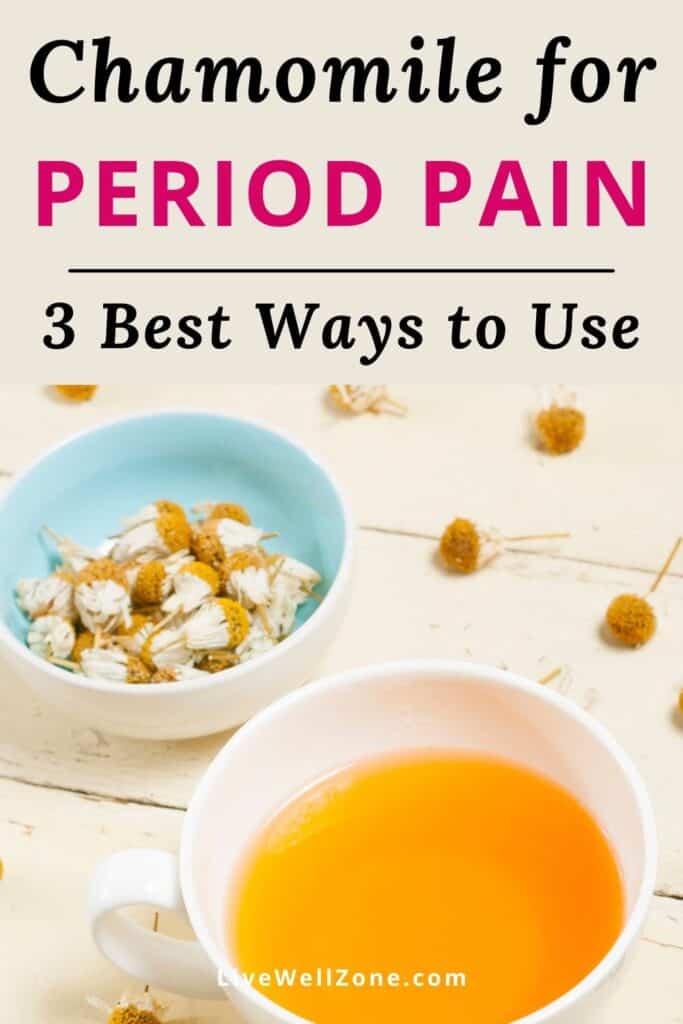
Related Articles:
Ginger Root for Heavy Periods: 3 Ways To Use It Effectively
7 Home Remedies for Menstrual Cramps (that you probably don’t know about)
10 Best Teas for Menstrual Cramps
How To Make The Best Smoothie for Period Cramps (That Actually Works!)
How To Sleep With Menstrual Cramps: 10 Tips To Get Relief and Feel Rested
How To Make Chamomile Tea For Sleep | Best, Powerful Recipe


